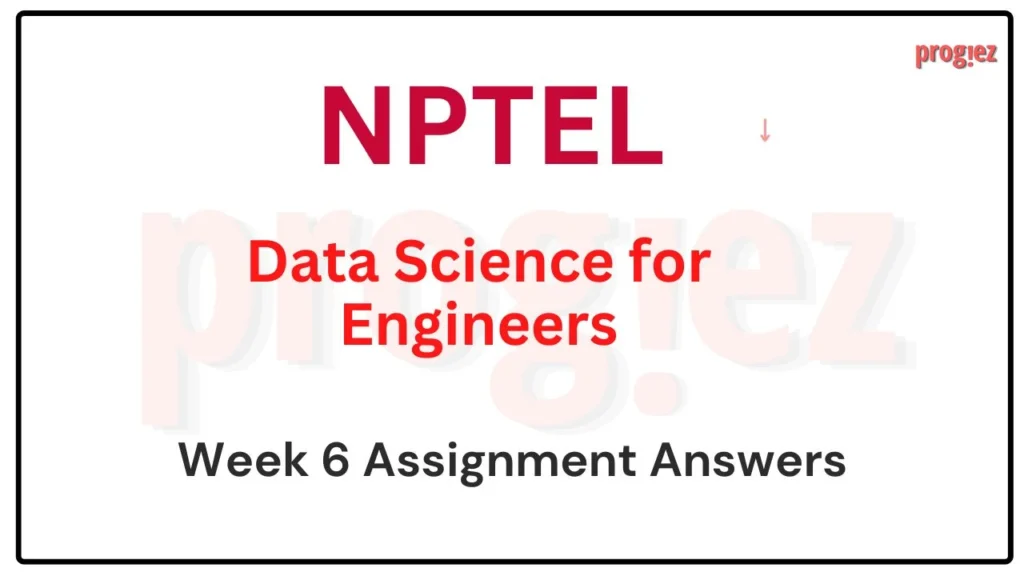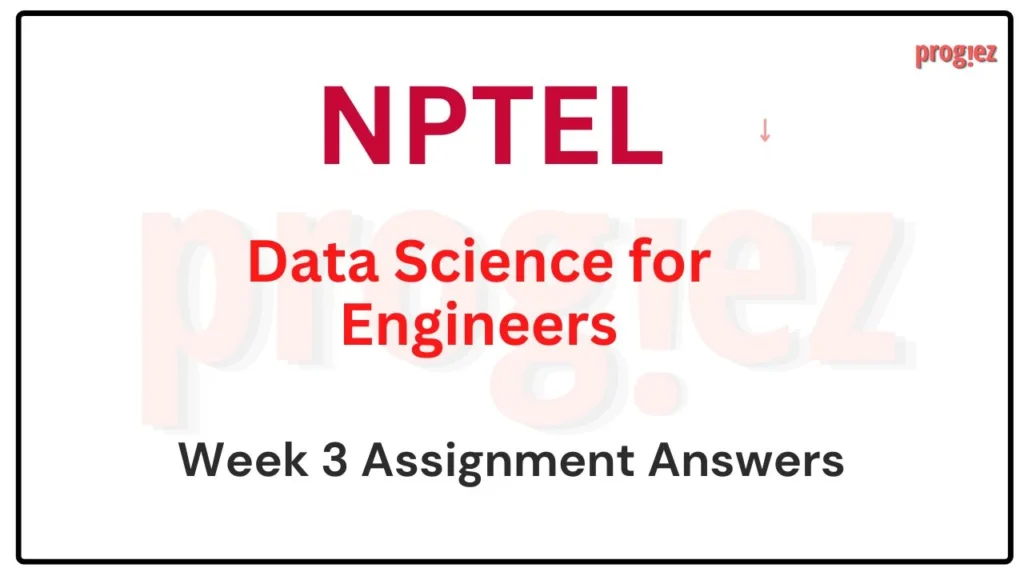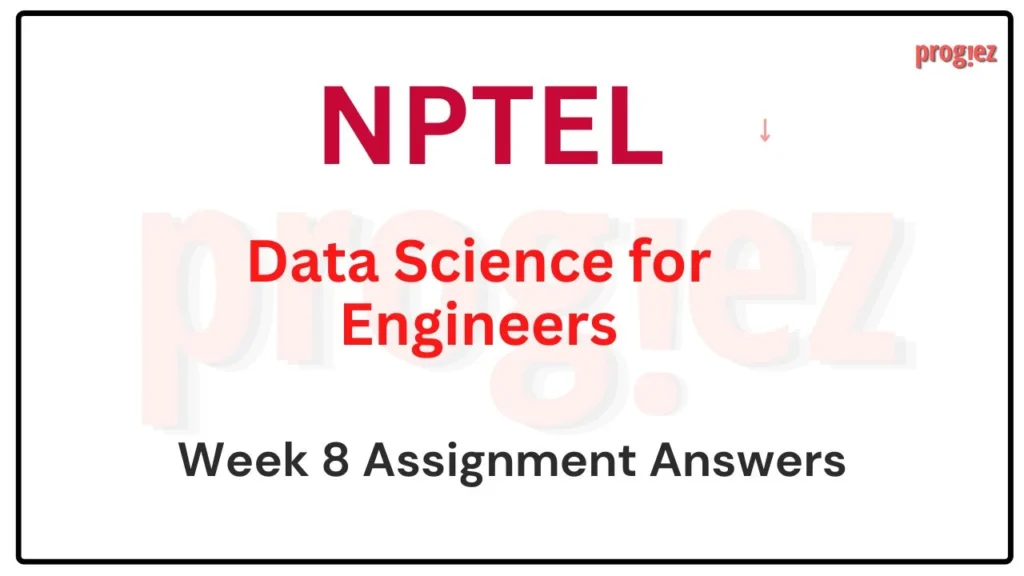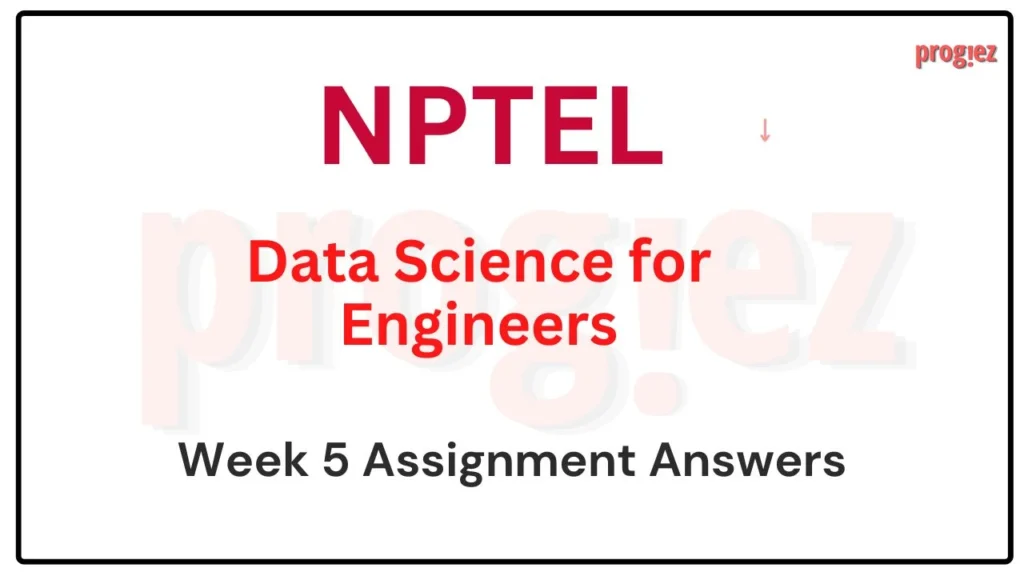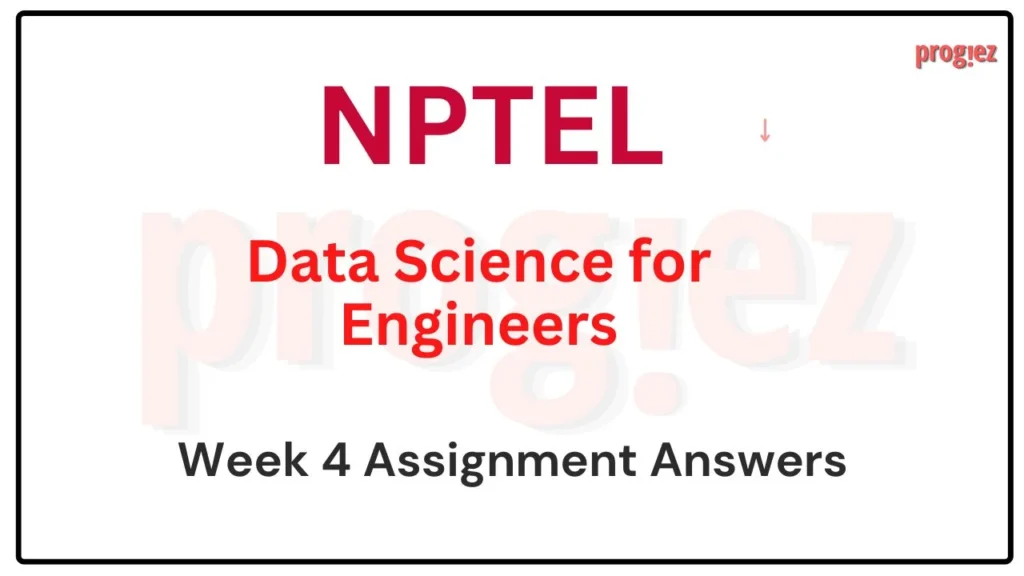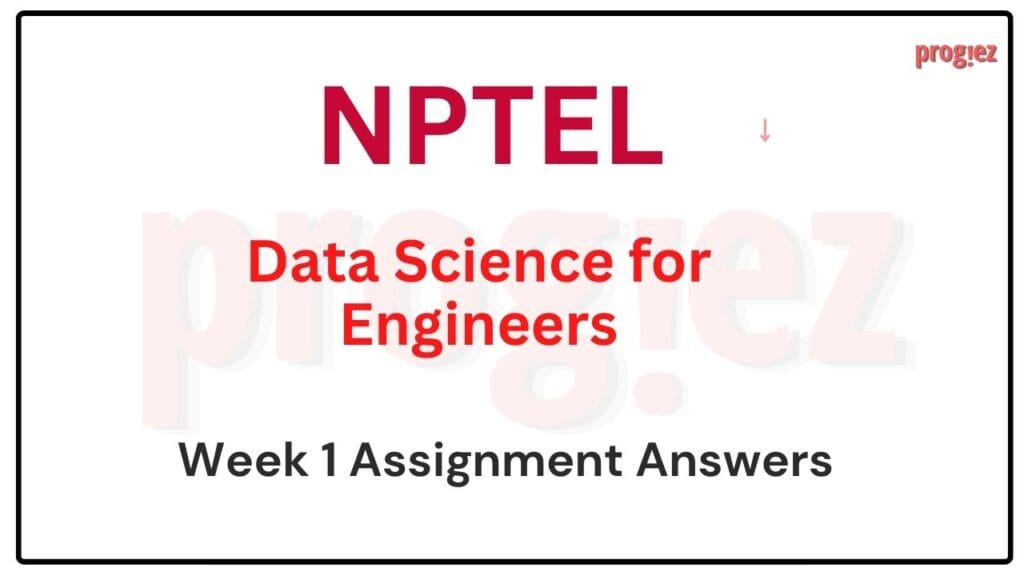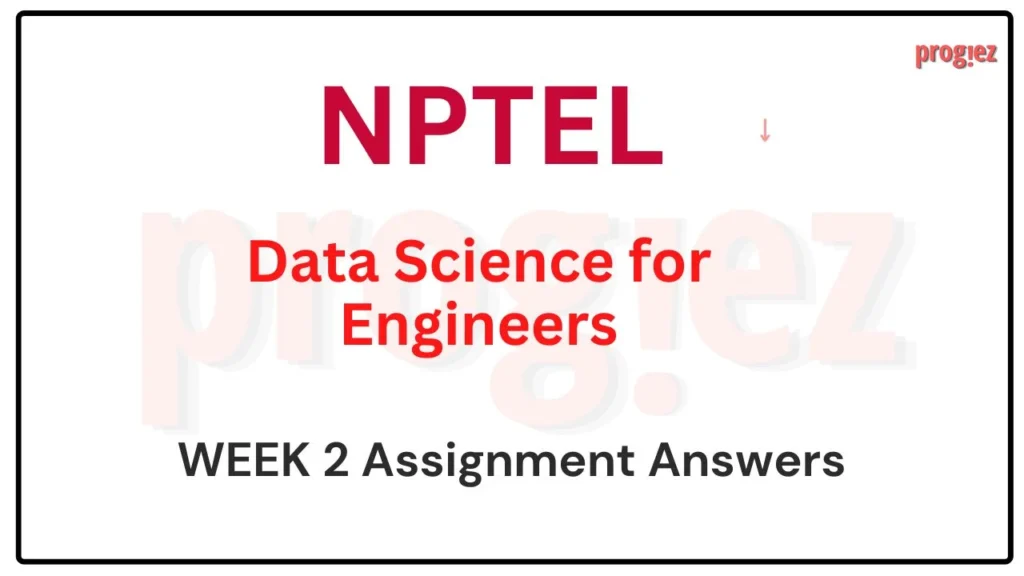Data Science for Engineers | Week 7
Session: JAN-APR 2024
Course Name: Data Science for Engineers
Course Link: Click Here
For answers or latest updates join our telegram channel: Click here to join
These are NPTEL Data Science for Engineers Assignment 7 Answers
Q1. Which among the following is not a type of cross-validation technique?
LOOCV
k-fold croos validation
Validation set approach
Bias variance trade off
Answer: d) Bias variance trade off
Q2. Which among the following is a classification problem?
Predicting the average rainfall in a given month.
Predicting whether a patient is diagnosed with a disease or not.
Predicting the price of a house.
Predicting whether it will rain or not tomorrow.
Answer: b, d
For answers or latest updates join our telegram channel: Click here to join
These are NPTEL Data Science for Engineers Assignment 7 Answers
Q3. Consider the following confusion matrix for the classication of Hatchback and SUV:
Find the accuracy of the model.
0.95
0.55
0.45
0.88
Answer: a) 0.95
Q4. Find the sensitivity of the model.
0.95
0.55
1
0.88
Answer: c) 1
For answers or latest updates join our telegram channel: Click here to join
These are NPTEL Data Science for Engineers Assignment 7 Answers
Q5. Under the ‘family’ parameter of glm() function, which one of the following distributions correspond to logistic regression for a variable with binary output?
Binomial
Gaussian
Gamma
Poisson
Answer: a) Binomial
Use the following information to answer Q6, Q7, Q8, Q9, and Q10:
Load the dataset iris.csv as a dataframe irisdata, with the first column as index headers, first row as column headers, dependent variable as factor variable, and answer the following questions.
Q6. The iris dataset contains four Sepal and Petal features (Sepal Length, Sepal Width, Petal Length, Petal Width, all in cm) of 50 equal samples of 3 different species of the iris flower (Setosa, Versicolor, and Virginica).
What is the dimension of the dataframe?
(150, 5)
(150, 4)
(50, 5)
None of the above
Answer: a) (150, 5)
For answers or latest updates join our telegram channel: Click here to join
These are NPTEL Data Science for Engineers Assignment 7 Answers
Q7. What can you comment on the distribution of the independent variables in the dataframe?
The variables Sepal Length and Sepal Width are not normally distributed
All the variables are normally distributed
The variable Petal Length alone is normally distributed
None of the above
Answer: b) All the variables are normally distributed
Q8. How many rows in the dataset contain missing values?
10
5
25
0
Answer: d) 0
For answers or latest updates join our telegram channel: Click here to join
These are NPTEL Data Science for Engineers Assignment 7 Answers
Q9. Which of the following code blocks can be used to summarize the data (finding the mean of the columns PetalLength and PetalWidth), similar to the one given below.
lapply(irisdata[, 3:4], mean)
sapply(irisdata[, 3:4], 2, mean)
apply(irisdata[, 3:4], 2, mean)
apply(irisdata[, 3:4], 1, mean)
Answer: a), c)
Q10. What can be interpreted from the plot shown below?
Sepal widths of Versicolor flowers are lesser than 3 cm.
Sepal lengths of Setosa flowers are lesser than 6 cm.
Sepal lengths of Virginica flowers are greater than 6 cm.
Sepals of Setosa flowers are relatively more wider than Versicolor flowers.
Answer: b), d)
For answers or latest updates join our telegram channel: Click here to join
These are NPTEL Data Science for Engineers Assignment 7 Answers
More Solutions of Data Science for Engineers: Click Here
More Nptel Courses: Click here
Session: JULY-DEC 2023
Course Name: Data Science for Engineers
Course Link: Click Here
These are NPTEL Data Science for Engineers Assignment 7 Answers
Q1. Which among the following is not a type of cross-validation technique?
LOOCV
k-fold croos validation
Validation set approach
Bias variance trade off
Answer: Bias variance trade off
Q2. Which among the following is a classification problem?
Predicting the average rainfall in a given month.
Predicting whether a patient is diagnosed with a disease or not.
Predicting the price of a house.
Predicting whether it will rain or not tomorrow.
Answer: Predicting whether a patient is diagnosed with a disease or not.
Predicting whether it will rain or not tomorrow.
These are NPTEL Data Science for Engineers Assignment 7 Answers
Q3. Find the accuracy of the model.
0.95
0.55
0.45
0.88
Answer: 0.95
Q4. Find the sensitivity of the model.
0.95
0.55
1
0.88
Answer: 1
These are NPTEL Data Science for Engineers Assignment 7 Answers
Q5. Under the ‘family’ parameter of glm() function, which one of the following distributions correspond to logistic regression for a variable with binary output?
Binomial
Gaussian
Gamma
Poisson
Answer: Binomial
Use the following information to answer Q6 – Q10:
Load the dataset iris.csv as a dataframe irisdata, with the first column as index headers, first row as column headers, dependent variable as factor variable, and answer the following questions.
The iris dataset contains four Sepal and Petal features (Sepal Length, Sepal Width, Petal Length, Petal Width, all in cm) of 50 equal samples of 3 different species of the iris flower (Setosa, Versicolor, and Virginica).
Q6. What is the dimension of the dataframe?
(150, 5)
(150, 4)
(50, 5)
None of the above
Answer: (150, 5)
These are NPTEL Data Science for Engineers Assignment 7 Answers
Q7. What can you comment on the distribution of the independent variables in the dataframe?
The variables Sepal Length and Sepal Width are not normally distributed
All the variables are normally distributed
The variable Petal Length alone is normally distributed
None of the above
Answer: All the variables are normally distributed
Q8. How many rows in the dataset contain missing values?
10
5
25
0
Answer: 0
These are NPTEL Data Science for Engineers Assignment 7 Answers
Q9. Which of the following code blocks can be used to summarize the data (finding the mean of the columns PetalLength and PetalWidth), similar to the one given below.
lapply(irisdata[, 3:4], mean)
sapply(irisdata[, 3:4], 2, mean)
apply(irisdata[, 3:4], 2, mean)
apply(irisdata[, 3:4], 1, mean)
Answer: lapply(irisdata[, 3:4], mean)
apply(irisdata[, 3:4], 2, mean)
Q10. What can be interpreted from the plot shown below?
Sepal widths of Versicolor flowers are lesser than 3 cm.
Sepal lengths of Setosa flowers are lesser than 6 cm.
Sepal lengths of Virginica flowers are greater than 6 cm.
Sepals of Setosa flowers are relatively more wider than Versicolor flowers.
Answer: C, D
These are NPTEL Data Science for Engineers Assignment 7 Answers
More Solutions of Data Science for Engineers: Click Here
More Nptel Courses: Click here
Course Name: Data Science for Engineers
Course Link: Click Here
These are NPTEL Data Science for Engineers Assignment 7 Answers
Q1. Which among the following is not a type of cross-validation technique?
a. LOOCV
b. k-fold croos validation
c. Validation set approach
d. Bias variance trade off
Answer: d. Bias variance trade off
Q2. Which among the following is a classification problem?
a. Predicting the average rainfall in a given month.
b. Predicting whether a patient is diagnosed with a disease or not.
c. Predicting the price of a house.
d. Predicting whether it will rain or not tomorrow.
Answer: b, c
These are NPTEL Data Science for Engineers Assignment 7 Answers
Consider the following confusion matrix for the classication of Hatchback and SUV:

Q3. Find the accuracy of the model.
a. 0.95
b. 0.55
c. 0.45
d. 0.88
Answer: a. 0.95
Q4. Find the sensitivity of the model.
a. 0.95
b. 0.55
c. 1
d. 0.88
Answer: c. 1
These are NPTEL Data Science for Engineers Assignment 7 Answers
Q5. Under the ‘family’ parameter of glm() function, which one of the following distributions correspond to logistic regression for a variable with binary output?
a. Binomial
b. Gaussian
c. Gamma
d. Poisson
Answer: a. Binomial
Use the following information to answer Q6, Q7, Q8, Q9, and Q10:
Load the dataset iris.csv as a dataframe irisdata, with the first column as index headers, first row as column headers, dependent variable as factor variable, and answer the following questions.
The iris dataset contains four Sepal and Petal features (Sepal Length, Sepal Width, Petal Length, Petal Width, all in cm) of 50 equal samples of 3 different species of the iris flower (Setosa, Versicolor, and Virginica).
Q6. What is the dimension of the dataframe?
a. (150, 5)
b. (150, 4)
c. (50, 5)
d. None of the above
Answer: a. (150, 5)
These are NPTEL Data Science for Engineers Assignment 7 Answers
Q7. What can you comment on the distribution of the independent variables in the dataframe?
a. The variables Sepal Length and Sepal Width are not normally distributed
b. All the variables are normally distributed
c. The variable Petal Length alone is normally distributed
d. None of the above
Answer: a. The variables Sepal Length and Sepal Width are not normally distributed
Q8. How many rows in the dataset contain missing values?
a. 10
b. 5
c. 25
d. 0
Answer: d. 0
These are NPTEL Data Science for Engineers Assignment 7 Answers
Q9. Which of the following code blocks can be used to summarize the data (finding the mean of the columns PetalLength and PetalWidth), similar to the one given below.

a. lapply(irisdata[, 3:4], mean)
b. sapply(irisdata[, 3:4], 2, mean)
c. apply(irisdata[, 3:4], 2, mean)
d. apply(irisdata[, 3:4], 1, mean)
Answer: c. apply(irisdata[, 3:4], 2, mean)
Q10. What can be interpreted from the plot shown below?

a. Sepal widths of Versicolor flowers are lesser than 3 cm.
b. Sepal lengths of Setosa flowers are lesser than 6 cm.
c. Sepal lengths of Virginica flowers are greater than 6 cm.
d. Sepals of Setosa flowers are relatively more wider than Versicolor flowers
Answer: a, d
These are NPTEL Data Science for Engineers Assignment 7 Answers
More Solutions of Data Science for Engineers: Click Here
More NPTEL Solutions: https://progiez.com/nptel-assignment-answers/

